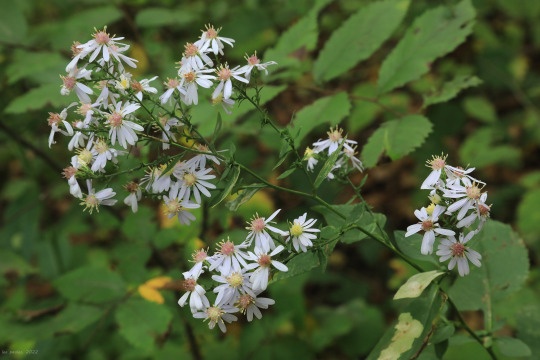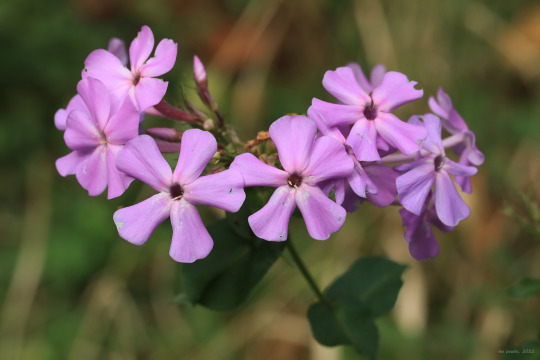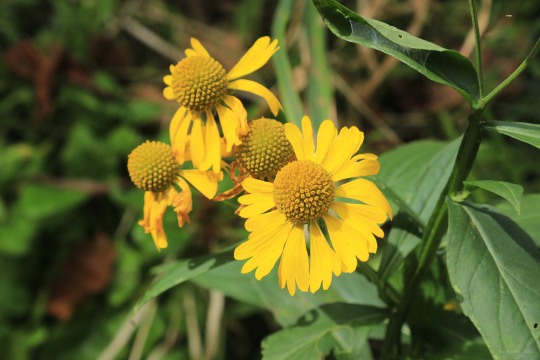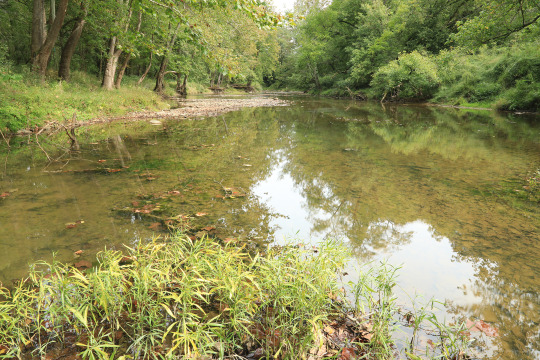#broadleaved goldenrod
Photo









Early fall color along Dunkard Creek at the Mason-Dixon Historical Park. Most notably, broadleaved goldenrod (Solidago flexicaulis), also known as zig-zag goldenrod, is now in bloom. This is one of my favorite wildflowers of any season - it grows in gorgeous clumps with brilliant gold flower spikes and broadly-ovate, sharply serrated foliage. It’s better behaved than most goldenrods and is ideal for a bright pop of autumn color in a native wildflower garden.
From top: broadleaved goldenrod, one of two species in this area with flowers growing from the leaf axils; blue wood aster (Symphyotrichum cordifolium), a common woodland aster that blooms right up to the first frost; garden phlox (Phlox paniculata), also known as tall phlox and fall phlox, a tall, wetlands-loving perennial that blooms from July through early October in Central Appalachia; sneezeweed (Helenium autumnale), which loves the marshy edges of ponds, lakes, and streams; short’s aster (Symphyotrichum shortii), a woodland aster with a special fondness for limestone bluffs.
#appalachia#vandalia#west virginia#pennsylvania#fall#autumn#dunkard creek#mason-dixon historical park#solidago flexicaulis#broadleaved goldenrod#zig-zag goldenrod#symphyotrichum cordifolium#blue wood aster#phlox paniculata#garden phlox#tall phlox#fall phlox#helenium autumnale#common sneezeweed#symphyotrichum shortii#short's aster#wildflowers#flora
56 notes
·
View notes
Note
Frank I'm working on a world building project, would you mind helping me create some plants for the fantasy world? Either naming them or drawing them would be great!
Fantasy Plants I love writing in a fantasy setting, and while I've tried to draw a few plant concepts before, I haven't yet managed to capture the beauty of the plants of real life (which are of course fantastical in nature!). I figured some plants from real life would be great as inspiration for fantasy plants. The world I've written most about is a pre-industrial setting in the Northern Hemisphere, specifically a land with cold winters where a great many plants are frost tolerant, and warm summers where a great many plants are temperate. I'd like to have a good selection of all those and some additional plants in a fantasy setting.
I will say that I am not well-versed in plant biology, so I'm open to hearing suggestions for improvements on the list below. For each plant, I provide an image from my Google search, and the name of the plant as well. Feel free to use these images as a reference for your own world building projects, with credit as always.
1. Arctic plants and other cold-loving plants
Name: arctic plants
Image: Ice floe
Plant type: a sub-branch of the conifer family Pinaceae, the true trees of arctic regions, where they are dominant plants in some areas, like Canada
Name: mosses
Image: arctic moss
Plant type: non-flowering plants, often in tufts, with thick, often dark, dark green and often waxy-looking blades
Name: lichen
Image: white spots of lichen
Plant type: an association between a fungus and a bacteria, often with green patches where the fungus has taken hold
Name: northern grassland wildflower
Image: flower of goldenrod (Solidago virgaurea)
Plant type: flowering perennials in the aster family
Name: Arctic heath
Image: flower spikes of mountain aven (Avenella corundens)
Plant type: perennial plants often growing in heaths and grasslands
Name: polar bear hair moss
Image: a moss in the genus Scleropodium, growing in rocky areas
Plant type: moss
Name: Arctic dwarf shrubs
Image: flowering dwarf shrubs in the buckthorn family
Plant type: flowering perennial shrubs in the dogbane family, often of low stature and with yellow flowers
Name: mosses
Image: arctic moss
Plant type: non-flowering plants, often in patches
Name: mountain aven
Image: flower spikes of mountain aven
Plant type: perennial plants often growing in heaths and grasslands
Name: willow
Image: flowering dwarf shrub in the flowering pellitory family
Plant type: flowering perennial dwarf shrubs in the rose family
Name: cinquefoil
Image: a plant in the quillweed family, growing in grassy meadows
Plant type: a perennial plant in the sunflower family
Name: sphagnum moss
Image: patches of sphagnum moss, a perennial herb
Plant type: a grass that does not have leaves
Name: reindeer moss
Image: white patches on a rock
Plant type: a moss with thick, stiff, white blades
2. Temperate and tropical plants
Name: conifers
Image: Douglas fir
Plant type: tree, pine and spruce conifer in the family Pinaceae
Name: broadleaved deciduous trees
Image: a deciduous tree in the oak family
Plant type: an evergreen tree in the oak family
Name: elm
Image: flower of the elm
Plant type: tree with evergreen leaves
Name: grassland plants
Image: flowering perennials in the daisy family
Plant type: flowering perennial grasses in the grass family
Name: juniper
Image: fruit of the juniper tree in the cypress family
Plant type: flowering tree in the cypress family
Name: dogwood
Image: fruit of the dogwood tree in the mountain laurel family
Plant type: flowering tree in the aster family
Name: wildflower
Image: yellow flowers of mountain asters
Plant type: a species of aster
Name: flowering dwarf shrub
Image: purple-fruited flowering shrubs in the heather family
Plant type: flowering species in the rose family
Name: flowering plants
Image: yellow flowers of flowering plants
Plant type: flowering plants
Name: grasses
Image: golden grasses
Plant type: grasses without leaves
Name: mountain aven
Image: flower spikes of mountain aven
Plant type: flowering perennial dwarf shrubs in the dogbane family
4, Insects, nematodes, and other forms
Name: flower crab crab
Image: yellow crab flowers
Type: plant associated with a crab, typically with a green stem and dark green to blackish-fruited leaves
Name: flowering crab
Image: yellow crabflower
Plant Type: flowering crab
Name: flowering crab
Image: flower of the crab plant
Plant Type: flowering crab
Plant name: crab crab crab crab crab crab crab crab crab crab crab crab crab crab crab crab crab crab crab crab crab crab crab crab crabs crab crab crab crab crab crab crab crab crab crab crab crab crab crab crab crab crab crab crab crab a crab crab crab crab crab crab crab crab crab crab crab crab crab crab crab crab crab crabs and a thehhhhhhhhhhhhhhhhhhhhhhhhhhhhhhhhhhhhhhhhhhhhhhhhhhhhhhhhhhhhhhhhhhhhhhhhhhhhhhhhhhhhhhhhhhehehehe
14 notes
·
View notes